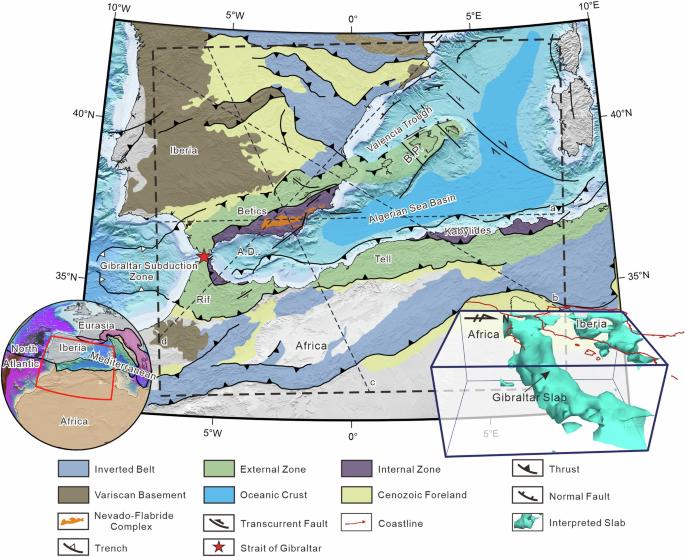直布罗陀板块的直立位移及邻近前陆和弧后盆地的断裂起源
IF 8.1
1区 地球科学
Q1 ENVIRONMENTAL SCIENCES
引用次数: 0
摘要
俯冲系统中的弧后盆地通常是在与俯冲有关的离散延伸阶段之后形成的。然而,在地中海最西端,与巴伦西亚海槽和阿尔及利亚海盆相关的新生代延伸的启动几乎同时在直布罗陀俯冲系统中引入了两个延伸中心,这对理解其基本动态提出了挑战。我们在构造重建的约束下建立了随时间变化的三维地球动力学模型,以确定直布罗陀俯冲在形成非常规伸展盆地过程中的作用。我们的研究结果表明,阿尔及利亚海盆是一个典型的弧后盆地,而巴伦西亚海槽则是在直布罗陀板块旋转回滚过程中在俯冲板块上形成的。此外,巴伦西亚海槽的延伸很可能延迟了板块撕裂,并在其最终脱离之前引导板块下沉,从而促进了其最终的直立定位。我们展示了板块和地幔如何在板块非对称回滚的俯冲系统中动态互动。利用数值地球动力学模型进行的研究显示,由于直布罗陀板块的旋转回滚,西地中海的巴伦西亚海槽和阿尔及利亚海盆同时形成。本文章由计算机程序翻译,如有差异,请以英文原文为准。

Upright emplacement of the Gibraltar slab and the origin of rifting in adjacent foreland and Backarc Basins
Back-arc basins in subduction systems usually form following discrete subduction-related extension stages. However, in the westernmost Mediterranean, the initiation of Cenozoic extension associated with the Valencia Trough and Algerian Sea Basin introduced two extension centers nearly simultaneously in the Gibraltar subduction system, and this presents a challenge to understanding their underlying dynamics. We built three-dimensional time-dependent geodynamic models constrained by tectonic reconstructions to determine the role that the Gibraltar subduction played in shaping unconventional extensional basins. Our results suggest that the Algerian Sea Basin is a typical back-arc basin, whereas the Valencia Trough opened on the subducting plate during the rotational rollback of the Gibraltar slab. Moreover, the Valencia Trough extension likely delayed slab tearing and guided slab sinking before its final detachment, facilitating its ultimate upright positioning. We show how plates and the mantle interact dynamically in a subduction system where the slab asymmetrically rolls back. The Valencia Trough and the Algerian Sea Basin in the Western Mediterranean formed simultaneously due to the rotational rollback of the Gibraltar slab, a study using numerical geodynamic models reveals.
求助全文
通过发布文献求助,成功后即可免费获取论文全文。
去求助
来源期刊

Communications Earth & Environment
Earth and Planetary Sciences-General Earth and Planetary Sciences
CiteScore
8.60
自引率
2.50%
发文量
269
审稿时长
26 weeks
期刊介绍:
Communications Earth & Environment is an open access journal from Nature Portfolio publishing high-quality research, reviews and commentary in all areas of the Earth, environmental and planetary sciences. Research papers published by the journal represent significant advances that bring new insight to a specialized area in Earth science, planetary science or environmental science.
Communications Earth & Environment has a 2-year impact factor of 7.9 (2022 Journal Citation Reports®). Articles published in the journal in 2022 were downloaded 1,412,858 times. Median time from submission to the first editorial decision is 8 days.
 求助内容:
求助内容: 应助结果提醒方式:
应助结果提醒方式:


